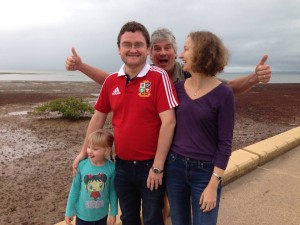Swimming in fecally-contaminated natural waterbodies can result in gastrointestinal (GI) infections and associated symptoms. However, the pathogenic microorganisms responsible are often unidentified because studies nearly always rely on self-reported symptoms. Noroviruses have been considered a likely cause because they are relatively resistant to conventional wastewater treatment and can survive in the environment.
 Symptoms among swimmers usually occur within a few days of exposure, consistent with a short incubation period characteristic of noroviruses.
Symptoms among swimmers usually occur within a few days of exposure, consistent with a short incubation period characteristic of noroviruses.
In the summer of 2009, we conducted an epidemiology study at a beach in Puerto Rico. We previously reported no association between swimming and self-reported GI symptoms at this beach. As part of this study, we also collected saliva samples from a subset of participants (N=1300) using an Oracol oral swab: on the day of the beach visit (S1); after 10-12 days (S2); and after approximately three weeks (S3), and tested them for IgG antibody responses to two common noroviruses (Norwalk and VA387) using a Luminex platform and a previously published method. An immunoconversion, indicating a potential new infection, was defined as at least a fourfold increase in norovirus-specific median fluorescence intensity (MFI) from the S1 to the S2 sample with the S3 sample remaining at least two times above the baseline (S1) MFI.
Approximately 4.7% (N=61) immunoconverted to at least one of the noroviruses. Swimmers who immersed their head in water had a higher rate of immunoconversion (5.5%) compared to non-swimmers (2.0%) (OR=3.32, 95% CI 1.2-9.5). Immunoconversion to norovirus was not associated with increased self-reported GI symptoms, indicating these infections were largely asymptomatic.
To our knowledge, this is the first epidemiology study to show an association between norovirus infection and swimming exposure. This abstract does not reflect EPA policy.
Evidence for asymptomatic norovirus infection transmission associated with swimming at a tropical beach
Soceity for Epidemiology Research, Miami, FL, June 07 – 16, 2016
Wade, Tim, S. Augustine, S. Griffin, K. Simmons, T. Eason, K. Oshima, E. Sams, A. Egorov, AND A. Dufour
https://cfpub.epa.gov/si/si_public_record_Report.cfm?dirEntryId=318202




 beach in Corsica, France on Monday (May 24).
beach in Corsica, France on Monday (May 24). It’s a good thing Hugh Jackman and his trainer work out at Sydney’s Bondi Beach (right, from a couple of days ago) rather than the city’s Northern Beaches, which have again been closed due to Salmonella.
It’s a good thing Hugh Jackman and his trainer work out at Sydney’s Bondi Beach (right, from a couple of days ago) rather than the city’s Northern Beaches, which have again been closed due to Salmonella.